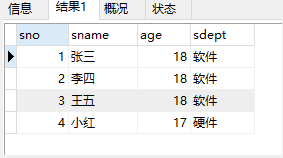

python3.6 使用 pymysql 连接 Mysql 数据库及 简单的增删改查操作_GIS数据共享
python3.6 使用 pymysql 连接 Mysql 数据库及 简单的增删改查操作
2023-03-12 11:41:46 浏览:3756 作者:管理员
1.通过 pip 安装 pymysql进入 cmd 输入 pip install pymysql 回车等待安装完成;安装完成后出现如图相关信息,表示安装成功。2.测试连接import pymysql #导入...
1.通过 pip 安装 pymysql
进入 cmd 输入 pip install pymysql
回车等待安装完成;
安装完成后出现如图相关信息,表示安装成功。
2.测试连接
import pymysql #导入 pymysql ,如果编译未出错,即表示 pymysql 安装成功
简单的增删改查操作
示例表结构
2.1查询操作
import pymysql #导入 pymysql
#打开数据库连接
db= pymysql.connect(host="localhost",user="root",
password="123456",db="test",port=3307)
# 使用cursor()方法获取操作游标
cur = db.cursor()
#1.查询操作
# 编写sql 查询语句 user 对应我的表名
sql = "select * from user"
try:
cur.execute(sql) #执行sql语句
results = cur.fetchall() #获取查询的所有记录
print("id","name","password")
#遍历结果
for row in results :
id = row[0]
name = row[1]
password = row[2]
print(id,name,password)
except Exception as e:
raise e
finally:
db.close() #关闭连接2.2插入操作
import pymysql #2.插入操作 db= pymysql.connect(host="localhost",user="root", password="123456",db="test",port=3307) # 使用cursor()方法获取操作游标 cur = db.cursor() sql_insert ="""insert into user(id,username,password) values(4,'liu','1234')""" try: cur.execute(sql_insert) #提交 db.commit() except Exception as e: #错误回滚 db.rollback() finally: db.close()
2.3更新操作
import pymysql
#3.更新操作
db= pymysql.connect(host="localhost",user="root",
password="123456",db="test",port=3307)
# 使用cursor()方法获取操作游标
cur = db.cursor()
sql_update ="update user set username = '%s' where id = %d"
try:
cur.execute(sql_update % ("xiongda",3)) #像sql语句传递参数
#提交
db.commit()
except Exception as e:
#错误回滚
db.rollback()
finally:
db.close()2.4删除操作
import pymysql #4.删除操作 db= pymysql.connect(host="localhost",user="root", password="123456",db="test",port=3307) # 使用cursor()方法获取操作游标 cur = db.cursor() sql_delete ="delete from user where id = %d" try: cur.execute(sql_delete % (3)) #像sql语句传递参数 #提交 db.commit() except Exception as e: #错误回滚 db.rollback() finally: db.close()
扫码查看
评论区
共 0 条评论
- 这篇文章还没有收到评论,赶紧来抢沙发吧~




